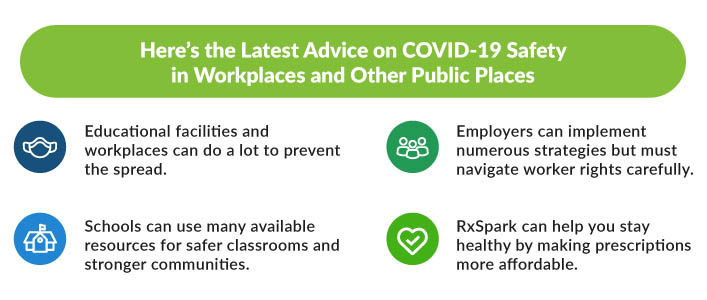
Review the most up-to-date preventative measures to stay COVID-compliant from the classroom to the boardroom
COVID-19 is still making its presence felt in America and around the world. The Centers for Disease Control and Prevention (CDC) is trying to keep pace by regularly updating their resources and public health advice to combat the spread and limit infection. It’s expert COVID-19 response guidance is designed to help employers and educators stay informed and proactive in prevention, constantly adapted by healthcare professionals to address the ever-changing landscape of the pandemic.
Mid-January saw the latest updates for educational facilities, with late 2021 yielding the most recent preventative measures for a healthier workplace. This guide will cover the CDC’s current guidance for these locations to help everyone stay safer and prevent the spread of COVID-19.
Coronavirus prevention advice for K-12 staff, students, and visitors
The recommendation for everyone 2 years old and older is to wear masks while on school grounds (and on any school transportation). The CDC also recommends schools keep an adequate supply of spare face masks on-premises to accommodate anyone not in possession of one. The agency views the following parties as exempt from mask requirements:
- Any person for whom wearing a face mask would interfere with the safe execution of their duties or otherwise create further health or safety risks.
- Any person who can’t wear a face covering or would find it difficult to do so effectively due to a disability must qualify under the Americans with Disabilities Act (ADA).
Anyone unable to use a mask under the second exception should discuss some form of reasonable accommodation with school authorities. A pro-vaccine stance is recommended for schools since vaccination is still the primary method of combating coronavirus disease. The CDC has published six key steps toward helping schools create a supportive, vaccine-oriented environment.
Educational staff should also consider implementing COVID-19 testing and contact tracing in schools while closely monitoring how COVID-19 cases impact their wider community so they can update their in-school strategy accordingly. The School Communities Toolkit offers multiple resources that all educational stakeholders can use to make a positive difference. It answers many frequently asked questions, for example how to discuss vaccination status with parents and stakeholders, and how to ensure proper cleaning and disinfection protocols are in place.
Layered protection and additional school strategies for preventing COVID-19
The CDC’s COVID-19 guidance states that those who can wear masks should do so whether they are vaccinated or unvaccinated. Physical distancing of 3 feet or more is still recommended, as are good hygiene practices such as handwashing and using hand sanitizer, remaining at home when unwell, and regular cleaning of surfaces. The agency also encourages attention to respiratory hygiene (such as covering your nose and mouth when sneezing) and effective ventilation throughout the facility.
Recommended quarantine times for any staff, students, or visitors affected by COVID-19 have been decreased to five days. Teachers can also implement cohorts as a further preventative measure to organize students into more manageable, COVID-friendly groups. Smaller numbers of pupils organized to stay together for the school day help limit the chances of cross-contamination in common areas, such as classrooms, the cafeteria, and playground settings.
Encouraging COVID-19 safety at work
Many educational best practices translate equally well into a work environment, such as regular surface cleaning and disinfection, social distancing, well-ventilated spaces, and sensible attendance based on current COVID-19 symptoms. CDC guidance for office buildings covers every base to better protect the structure and all occupants.
The agency recommends implementing an on-site workplace COVID-19 vaccination program if there are numerous employees with predictable work hours. If no facility is available at the workplace, employers can consider allowing staff time off to get vaccinated elsewhere or allow a mobile vaccination to set up nearby the worksite. All personnel involved in administering or handling sars-cov-2 (COVID-19) vaccines, regardless of location, must be properly trained to do so.
Employers can encourage their staff to protect themselves and those around them through a combination of messaging materials and making themselves readily available to address questions or concerns about vaccines. Using social media can also improve reception for prevention plans, and the CDC cites workplace incentives such as time off, gift cards, and bonuses as having the potential to boost staff vaccination rates.
Employers should prioritize virtual team meetings over in-person gatherings to avoid close contact whenever possible. Some employment roles necessitate travel, requiring those workers to follow CDC travel guidelines when using public transportation.
Workplace prevention and personal rights during the COVID-19 pandemic
Employers must keep in mind that they can only do so much to prevent COVID-19 exposure and protect workers while staying within the law. While all employees can comply with some preventive COVID-19 workplace safety measures, some may have medical or religious exemptions that prevent them from taking a vaccine. Abiding by the rules of the Equal Employment Opportunity Commission will help employers stay compliant.
Businesses with more than 100 employees must remember that the Occupational Safety and Health Administration’s (OSHA) vaccination and testing standards are mandatory steps toward prevention. There are also prevention tips for specific sectors, such as those designed to help the hospitality, air travel, and first-response professions.
Employers should always place a particular emphasis on caring for employees who fall into the high-risk health categories. Those with chronic pre-existing medical conditions, weight and respiratory issues, or in the older age demographic, face a higher risk from the virus.
These employees would benefit most from being granted telework privileges wherever possible to avoid COVID-19 exposure from colleagues. The CDC also emphasizes helping workers manage work-related stress since excess physical and mental tension often causes health to suffer and lowers the immune system’s efficacy.
Let ModRN Health help you stay as well as possible
Maintaining optimal health is never more crucial than during a pandemic, yet many Americans struggle to afford their medicine. ModRN Health can help reduce financial stress by finding the lowest prices on medications you need at locations near you.
You may save up to 80% on your current prescription expenses while earning redeemable reward points for every prescription you fill through our service. Open a free account today to learn more about how ModRN Health can help you look after your body and your budget.








